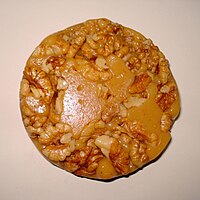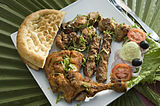food.wikisort.org - Dish
Sohan halwa (Urdu سوہن حلوہ; [ˈsoːɦən ˈɦəlʋaː]) is a traditional Mughlai[1] dessert in South Asia, which is a variety of dense, sweet confection or halwa. Gheewala halwa is popular for sohan halwa since the Mughal era. There are hundreds of shops that produce sohan halwa in the cities of Multan (Punjab), Dera Ismail Khan (Khyber Pakhtunkhwa), and Old Delhi.

 A variation of sohan halwa in the form of a circular disc | |
| Course | Dessert |
|---|---|
| Place of origin | West Asia and the Indian subcontinent |
| Main ingredients | cornflour, sugar, milk, water |
| Variations | Almonds |
| Other information | Halva |
It is made by boiling a mixture of water, sugar, milk, and cornflour until it becomes solid. Saffron is used for flavoring. Ghee is used to prevent it from sticking to the pan. Almonds, pistachios, and cardamom seeds are added. Unlike most other halwa dishes in the Indian subcontinent, it is solid, similar to its Middle Eastern counterparts.
History

In Old Delhi, a 225-year-old Ghantewala sweet shop established during the reign of Mughal Emperor Shah Alam II, (r. 1759 - 1806) in 1790, made sohan halwa, and was a popular attraction,[2][3] but in 2015 it closed due to a lack of profitability.[4]
This sweet was originally called Sohan in Khariboli (Hindi). The name is etymologically derived from the Sanskrit word Shobhan. According to John T. Platts' Dictionary of Urdu, Classical Hindi and English, the sweet was named after one Sohan Lal, so it has no connection with the Mugal Empire or indeed with Persia (Iran). As with many Indian sweets, this was also taken out of India and into Persia and elsewhere. [5]
Commercial production
Sohan halwa has been commercially produced by traditional confectioners for decades. It is brittle and caramelised, usually made into discs of 5-6mm thickness or as square bite-size pieces. It is usually packaged in intricately designed tin cylinders. In recent years other packages have also been common.[6]
See also
- Baklava
- Basbousa
- Halva
- Pişmaniye
- Saray helva
- Shekarpareh
- Sohan (confectionery)
- Soan papdi
References
- "Not Butter Chicken, Delhi Was Once Renowned For Its Sohan Halwa, Brief History Of The Sweet". Slurrp. Retrieved 27 March 2022.
The Mughals, who were of Persian descent, made this [Sohan] Halwa popular in India as well.
- Planet, Lonely. "Restaurants in Delhi, India".
- The royal treat in Chandni Chowk[Usurped!] The Hindu, Nov 07, 2002.
- "Ghantewala: Why did Delhi's 'oldest sweet shop' shut down?". BBC News. 24 July 2015.
- "A Dictionary of Urdu, Classical Hindi, and English". 1884.
- Ramazani, Nesta (1997). Persian Cooking: A Table Of Exotic Delights. Ibex Publishers, Inc. p. 296. ISBN 978-0-936347-77-6.
- Usman, Nizam Ud Deen. "Multani Sohan Halwa". Multani Sohan Halwa.
Другой контент может иметь иную лицензию. Перед использованием материалов сайта WikiSort.org внимательно изучите правила лицензирования конкретных элементов наполнения сайта.
WikiSort.org - проект по пересортировке и дополнению контента Википедии
